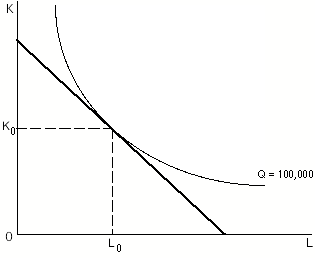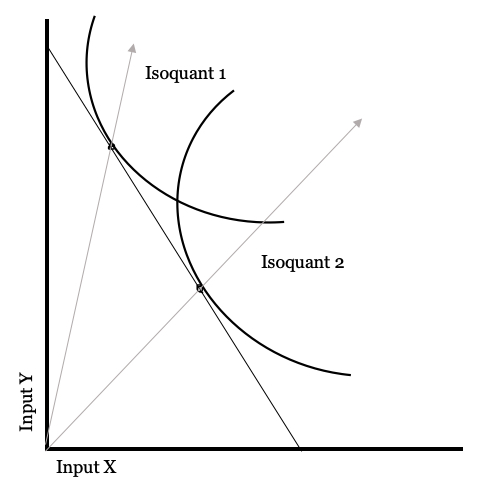|
Isocost
In economics, an isocost line shows all combinations of inputs which cost the same total amount.Chiang, Alpha C., ''Fundamental Methods of Mathematical Economics'', third edition, McGraw-Hill, 1984. Although similar to the budget constraint in consumer theory, the use of the isocost line pertains to cost-minimization in production, as opposed to utility-maximization. For the two production inputs labour and capital, with fixed unit costs of the inputs, the equation of the isocost line is :rK+wL = C\, where w represents the wage rate of labour, r represents the rental rate of capital, K is the amount of capital used, L is the amount of labour used, and C is the total cost of acquiring those quantities of the two inputs. The absolute value of the slope of the isocost line, with capital plotted vertically and labour plotted horizontally, equals the ratio of unit costs of labour and capital. The slope is: :-w/r. \, The isocost line is combined with the isoquant map to determine t ... [...More Info...] [...Related Items...] OR: [Wikipedia] [Google] [Baidu] |
Isoquant Isocost Graph
An isoquant (derived from quantity and the Greek word iso, meaning equal), in microeconomics, is a contour line drawn through the set of points at which the same quantity of output is produced while changing the quantities of two or more inputs. The x and y axis on an isoquant represent two relevant inputs, which are usually a factor of production such as labour, capital, land, or organisation. An isoquant may also be known as an “Iso-Product Curve”, or an “Equal Product Curve”. Isoquant vs. Indifference Curve While an indifference curve mapping helps to solve the utility-maximizing problem of consumers, the isoquant mapping deals with the cost-minimization and profit and output maximisation problem of producers. Indifference curves further differ to isoquants, in that they cannot offer a precise measurement of utility, only how it is relevant to a baseline. Whereas, from an isoquant, the product can be measured accurately in physical units, and it is known by exactly how ... [...More Info...] [...Related Items...] OR: [Wikipedia] [Google] [Baidu] |
Isoquant
An isoquant (derived from quantity and the Greek word iso, meaning equal), in microeconomics, is a contour line drawn through the set of points at which the same quantity of output is produced while changing the quantities of two or more inputs. The x and y axis on an isoquant represent two relevant inputs, which are usually a factor of production such as labour, capital, land, or organisation. An isoquant may also be known as an “Iso-Product Curve”, or an “Equal Product Curve”. Isoquant vs. Indifference Curve While an indifference curve mapping helps to solve the utility-maximizing problem of consumers, the isoquant mapping deals with the cost-minimization and profit and output maximisation problem of producers. Indifference curves further differ to isoquants, in that they cannot offer a precise measurement of utility, only how it is relevant to a baseline. Whereas, from an isoquant, the product can be measured accurately in physical units, and it is known by exactly how ... [...More Info...] [...Related Items...] OR: [Wikipedia] [Google] [Baidu] |
Expansion Path
In economics, an expansion path (also called a scale lineJain, TR; Khanna OP (2008). ''Economics.'' VK Publications, ) is a path connecting optimal input combinations as the scale of production expands.Hirschey, Mark (2008). ''Managerial economics.'' Cengage Learning, which is often represented as a curve in a graph with quantities of two inputs, typically physical capital and labor, plotted on the axes. A producer seeking to produce a given number of units of a product in the cheapest possible way chooses the point on the expansion path that is also on the isoquant associated with that output level.Prusty, Sadananda (2010). ''Managerial Economics.'' PHI Learning Pvt. Ltd., Economists Alfred Stonier and Douglas Hague defined “expansion path” as "that line which reflects the least–cost method of producing different levels of output, when factor prices remain constant."Stonier, Alfred W.; Hague, Douglas C. (1980). ''A textbook of economic theory, 5th edition.'' Longmans ... [...More Info...] [...Related Items...] OR: [Wikipedia] [Google] [Baidu] |
Marginal Rate Of Technical Substitution
In microeconomic theory, the marginal rate of technical substitution (MRTS)—or technical rate of substitution (TRS)—is the amount by which the quantity of one input has to be reduced (-\Delta x_2) when one extra unit of another input is used (\Delta x_1 = 1), so that output remains constant (y = \bar). MRTS(x_1,x_2) =-\frac = \frac where MP_1 and MP_2 are the marginal products of input 1 and input 2, respectively. Along an isoquant, the MRTS shows the rate at which one input (e.g. capital or labor) may be substituted for another, while maintaining the same level of output. Thus the MRTS is the absolute value of the slope of an isoquant at the point in question. When relative input usages are optimal, the marginal rate of technical substitution is equal to the relative unit costs of the inputs, and the slope of the isoquant at the chosen point equals the slope of the isocost curve (see Conditional factor demands). It is the rate at which one input is substituted for another ... [...More Info...] [...Related Items...] OR: [Wikipedia] [Google] [Baidu] |
Economics
Economics () is the social science that studies the Production (economics), production, distribution (economics), distribution, and Consumption (economics), consumption of goods and services. Economics focuses on the behaviour and interactions of Agent (economics), economic agents and how economy, economies work. Microeconomics analyzes what's viewed as basic elements in the economy, including individual agents and market (economics), markets, their interactions, and the outcomes of interactions. Individual agents may include, for example, households, firms, buyers, and sellers. Macroeconomics analyzes the economy as a system where production, consumption, saving, and investment interact, and factors affecting it: employment of the resources of labour, capital, and land, currency inflation, economic growth, and public policies that have impact on glossary of economics, these elements. Other broad distinctions within economics include those between positive economics, desc ... [...More Info...] [...Related Items...] OR: [Wikipedia] [Google] [Baidu] |
Budget Constraint
In economics, a budget constraint represents all the combinations of goods and services that a consumer may purchase given current prices within his or her given income. Consumer theory uses the concepts of a budget constraint and a preference map as tools to examine the parameters of consumer choices . Both concepts have a ready graphical representation in the two-good case. The consumer can only purchase as much as their income will allow, hence they are constrained by their budget. The equation of a budget constraint is P_x x+P_y y=m where P_x is the price of good X, and P_y is the price of good Y, and m = income. Soft budget constraint The concept of soft budget constraints is commonly applied to economies in transition. This theory was originally proposed by János Kornai in 1979. It was used to explain the "economic behavior in socialist economies marked by shortage”. In the socialist transition economy there are soft budget constraint on firms because of subsidies, c ... [...More Info...] [...Related Items...] OR: [Wikipedia] [Google] [Baidu] |
Consumer Theory
The theory of consumer choice is the branch of microeconomics that relates preferences to consumption expenditures and to consumer demand curves. It analyzes how consumers maximize the desirability of their consumption as measured by their preferences subject to limitations on their expenditures, by maximizing utility subject to a consumer budget constraint. Factors influencing consumers' evaluation of the utility of goods: income level, cultural factors, product information and physio-psychological factors. Consumption is separated from production, logically, because two different economic agents are involved. In the first case consumption is by the primary individual, individual tastes or preferences determine the amount of pleasure people derive from the goods and services they consume.; in the second case, a producer might make something that he would not consume himself. Therefore, different motivations and abilities are involved. The models that make up consumer theory ar ... [...More Info...] [...Related Items...] OR: [Wikipedia] [Google] [Baidu] |
Factors Of Production
In economics, factors of production, resources, or inputs are what is used in the production process to produce output—that is, goods and services. The utilized amounts of the various inputs determine the quantity of output according to the relationship called the production function. There are four ''basic'' resources or factors of production: land, labour, capital and entrepreneur (or enterprise). The factors are also frequently labeled "producer goods or services" to distinguish them from the goods or services purchased by consumers, which are frequently labeled "consumer goods". There are two types of factors: ''primary'' and ''secondary''. The previously mentioned primary factors are land, labour and capital. Materials and energy are considered secondary factors in classical economics because they are obtained from land, labour, and capital. The primary factors facilitate production but neither becomes part of the product (as with raw materials) nor becomes significantly tra ... [...More Info...] [...Related Items...] OR: [Wikipedia] [Google] [Baidu] |
Production Function
In economics, a production function gives the technological relation between quantities of physical inputs and quantities of output of goods. The production function is one of the key concepts of mainstream neoclassical theories, used to define marginal product and to distinguish allocative efficiency, a key focus of economics. One important purpose of the production function is to address allocative efficiency in the use of factor inputs in production and the resulting distribution of income to those factors, while abstracting away from the technological problems of achieving technical efficiency, as an engineer or professional manager might understand it. For modelling the case of many outputs and many inputs, researchers often use the so-called Shephard's distance functions or, alternatively, directional distance functions, which are generalizations of the simple production function in economics. In macroeconomics, aggregate production functions are estimated to create a fram ... [...More Info...] [...Related Items...] OR: [Wikipedia] [Google] [Baidu] |
Domitilla Del Vecchio
Domitilla Del Vecchio is an Italian control theorist, whose research connects control theory to systems biology, synthetic biology, synthetic biological circuits, and regenerative medicine. She has also studied self-organization in traffic control. She is a professor of mechanical engineering at the Massachusetts Institute of Technology (MIT), and a member of the MIT Synthetic Biology Center. Education and career Del Vecchio's father was a Roman engineer and her mother was a businesswoman. She earned a laurea at the University of Rome Tor Vergata in 1999, and completed a Ph.D. in control theory and dynamical systems from the California Institute of Technology in 2005. She became an assistant professor of electrical and engineering and computer science at the University of Michigan in 2006, also affiliated there with the Center for Computational Medicine and Bioinformatics. She moved to her present position at the Massachusetts Institute of Technology in 2010. Book Del Vecchio i ... [...More Info...] [...Related Items...] OR: [Wikipedia] [Google] [Baidu] |


